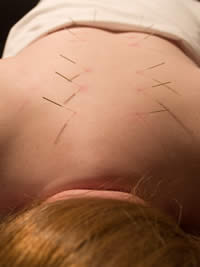 A collection of twelve very important acupuncture points called the Back Shu, or Back Transporting points are located on the Bladder meridian along the spine. There is a Back Transporting point for each of the six yin organs and each of the six yang organs. They are called “transporting” points because it is said that they transport “Qi” to the inner organs.
A collection of twelve very important acupuncture points called the Back Shu, or Back Transporting points are located on the Bladder meridian along the spine. There is a Back Transporting point for each of the six yin organs and each of the six yang organs. They are called “transporting” points because it is said that they transport “Qi” to the inner organs.
These acupuncture points are located on the inner Bladder meridian path, which is about an inch and a half from the mid-line of the spine. The Back Transporting points affect the organs directly and are especially important in the treatment of chronic diseases. Each of the points is named after the organ that it is associated with. For example, Bladder-13 connects with the Lung and is called Lung Shu. The Back Shu points also have the ability to affect the sense organ associated with the organ it is named for. For example, Bladder-18, the Back Shu point of the Liver is often used to treat eye diseases, because it is said that the Liver “opens to the eye”. Bladder-23, the Back Shu point of the Kidney can be used to treat tinnitus and other chronic ear problems related to Kidney deficiency.
The Back Shu points are acupuncture points where the Qi and Blood of a particular organ meet. These points not only treat diseases of their associated organs, they can also be diagnostic in nature. Sensitivity upon palpation indicates a pathology of that organ. A sharp pain elicited with pressure on the point indicates an excess condition and a dull ache with palpation indicates a deficient condition.
Parallel to each of the Back Shu points, located on the outer Bladder meridian line, three inches from the mid-line of the spine, is an acupuncture point that is more powerful to treat the emotional, mental and spiritual problems related to its associated organ. For example, Bladder-42 level with the Lung Back Shu, is used to treat emotional problems related to the Lung – sadness, grief and worry. It has a very soothing effect for those experiencing a prolonged period of sadness or grief.
The Back Shu points are stimulated with a variety of techniques. Sometimes acupuncture needles are used. If so, the needling technique is one of shallow, oblique insertion towards the spine to avoid a pneumothorax. Sometimes cupping is applied to the points. This is often done on points on the upper back in the early stages of the common cold. Herbal plasters may be applied to the points. In a recent article, I wrote about a summer treatment using herbal plasters on Lung Shu to strengthen the Lung to prevent the frequency and severity of asthma attacks the following winter. And finally, moxibustion can be used on these points. Burning the herb mugwort is commonly done on the Kidney Shu to treat yang deficiency conditions.
About the Author:
Joyce Marley is a licensed acupuncturist who provides acupuncture therapy in New Hartford, NY. She writes Traditional Chinese Medicine (TCM) health articles about acupuncture and Oriental medicine.



